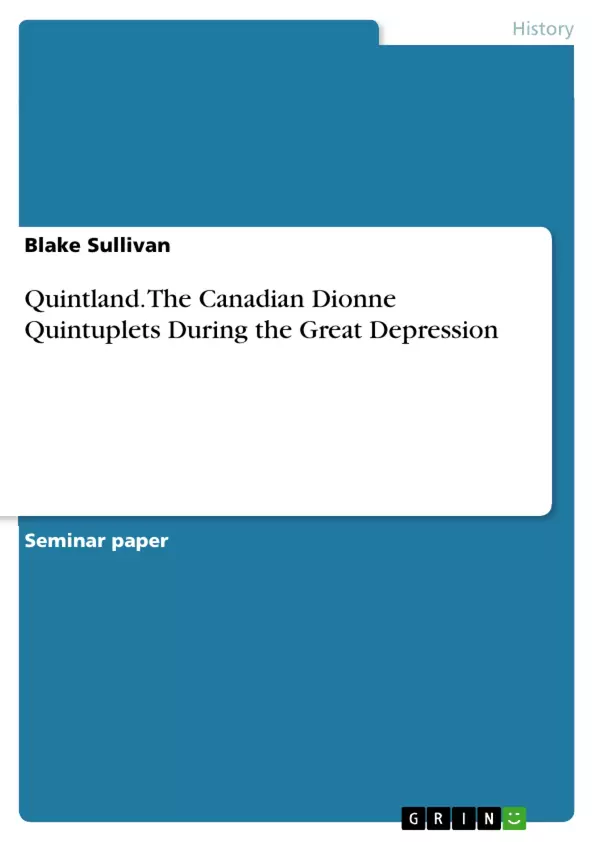The 1930s were very dark and depressing years for most Canadians. The Great Depression had global ramifications and Canada did not avoid the economic strain that was impacting the rest of the world: “millions of Canadians were out of work, and hundred of thousands more struggled to survive on drastically reduced incomes”. With the births of Annette, Cécile, Emilie, Marie and Yvonne Dionne in 1934, the province of Ontario, coupled with Canada, discovered a “Human Goldmine”. From the moment the Quints were born, they were subjected to awful living standards and were abused by the Provincial government for financial gains. But, why were the Dionne Quintuplets and their parents, Elzire and Oliva, manipulated into such a horrible fate? During an era that was struggling economically, the Ontario government took advantage of a very rare event to make short-term financial gains. The small Franco-Ontario hamlet of Corbeil, birthplace of the Quintuplets, became a booming tourist attraction that generated massive crowds and huge sums of money. By analyzing the Ontario government’s political policies during the Great Depression it is evident that the Dionne Quintuplets were unjustly treated as provincial property rather than ordinary children. Specifically, the Ontario Liberal government abused its political power and influence to legally, economically and culturally take advantage of a single family all to bolster its popularity and security in a depressing and dark era.
Table of Contents
- The 1930s: A Time of Economic Strain
- The Birth of the Dionne Quintuplets
- The Ontario Government's Intervention
- The Dionne Quints Guardianship Act of 1935
- The Dafoe Hospital and Nursery (Quintland)
Objectives and Key Themes
This paper examines the exploitation of the Dionne Quintuplets by the Ontario government during the Great Depression. It aims to shed light on the political and economic motivations behind the government's actions, highlighting the injustices faced by the Dionne family.
- The impact of the Great Depression on Canadian families
- The manipulation and exploitation of the Dionne Quintuplets for financial gain
- The abuse of political power by the Ontario Liberal government
- The ethical considerations surrounding the treatment of the Dionne family
- The role of media and public opinion in shaping the narrative surrounding the Quintuplets
Chapter Summaries
The first chapter examines the economic and social context of the Great Depression in Canada, highlighting the challenges faced by families during this period. It establishes the backdrop for the story of the Dionne Quintuplets, emphasizing the societal pressures and expectations surrounding families during this time.
The second chapter recounts the birth of the Dionne Quintuplets and the immediate public and media attention they received. It explores the financial difficulties faced by the Dionne family and the initial efforts by Oliva Dionne to secure financial support for his family.
The third chapter delves into the Ontario government's intervention in the lives of the Dionne Quintuplets. It analyzes the political motivations behind the government's actions, highlighting the power dynamics at play and the legal framework that allowed for the government's control over the Quintuplets.
The fourth chapter examines the consequences of the Dionne Quints Guardianship Act of 1935 and the establishment of the Dafoe Hospital and Nursery (Quintland). It discusses the government's exploitation of the Quintuplets for financial gain and the ethical implications of their actions.
Keywords
The main keywords and focus topics of this text are: the Great Depression, the Dionne Quintuplets, the Ontario government, exploitation, political power, financial gain, ethical implications, media manipulation, and public opinion.
- Citation du texte
- Blake Sullivan (Auteur), 2014, Quintland. The Canadian Dionne Quintuplets During the Great Depression, Munich, GRIN Verlag, https://www.grin.com/document/285192



